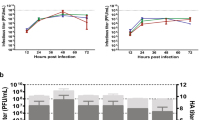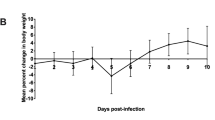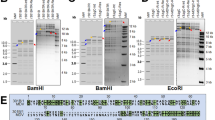Abstract
IN genetic interaction between the MEL and NWS strains of influenza A virus it is convenient to regard the production of specific lesions in the chick embryo and pathogenicity for the mouse which has been inoculated intra-cerebrally with the virus as separate heritable characteristics, both of which are transferable from NWS to MEL 1. It has been a feature of Australian work that recombinant, N–M, strains produced by double infection of the allantoic cavity of the chick embryo are not pathogenic for the mouse (Fraser, K. B., and Burnet, F. M., unpublished work). On the other hand, American work records combination forms, produced in the fertile egg, which are virulent for the mouse2, but the methods of production of N–M strains in the two laboratories are not strictly comparable. Our techniques concentrated on limiting the time of virus production to a short infectious cycle of about eight hours, which was initiated in the washed allantoic cavity3 and from which the original inoculum was largely removed before the new yield became available, whereas American methods used both the washed and the intact allantois, variable reproductive times up to forty hours and inocula irradiated with ultra-violet. The precise source of the most virulent recombinant of the MEL type is not described; but in general, transfer of pathogenicity was most effective with small doses and after long reproductive cycles2. The most likely explanations of the failure of our hybrid strains to acquire pathogenicity to the mouse were thus the washing out of the allantoic sac or the limiting of reproduction to one cycle.
This is a preview of subscription content, access via your institution
Access options
Subscribe to this journal
Receive 51 print issues and online access
$199.00 per year
only $3.90 per issue
Buy this article
- Purchase on Springer Link
- Instant access to full article PDF
Prices may be subject to local taxes which are calculated during checkout
Similar content being viewed by others
References
Lind, Patricia E., and Burnet, F. M., Austral. J. Exp. Biol. and Med. Sci., 32, 437 (1954).
Hirst, George K., and Gottlieb, Tamar, Virology, 1, 221 (1955).
Fraser, K. B., and Burnet, F. M., Austral. J. Exp. Biol. and Med. Sci., 30, 459 (1952).
Fraser, K. B., Brit. J. Exp. Path., 34, 319 (1953).
Burnet, F. M., and Lind, Patricia E., Nature, 173, 627 (1954).
Author information
Authors and Affiliations
Rights and permissions
About this article
Cite this article
FRASER, K. A Two-stage Transfer of Pathogenicity between the MEL and NWS Strains of Influenza A Virus. Nature 181, 195–196 (1958). https://doi.org/10.1038/181195a0
Issue Date:
DOI: https://doi.org/10.1038/181195a0
Comments
By submitting a comment you agree to abide by our Terms and Community Guidelines. If you find something abusive or that does not comply with our terms or guidelines please flag it as inappropriate.



